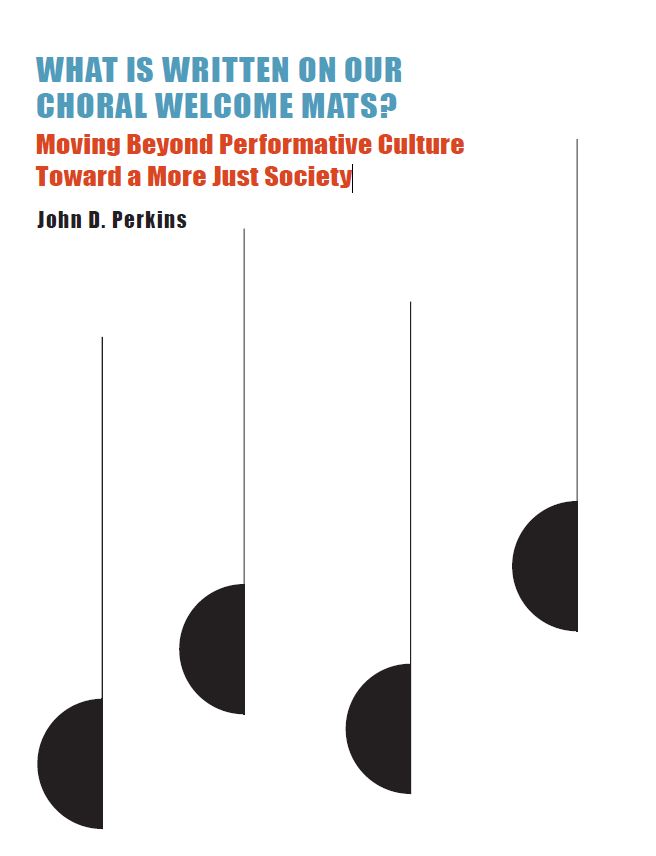
The December 2018 issue of Choral Journal is now available online. Below is an excerpt of the article “What is Written on Our Choral Welcome Mats? Moving Beyond Performative Culture Toward a More Just Society” by John D. Perkins. You can read it in its entirety online at acda.org/choraljournal. Click “Search Archives” and choose December 2018 from the dropdown menu.
_____________________________
After teaching choral music at a university in the United Arab Emirates (UAE) for six years, I returned to the United States for my present position. The contrast between the two experiences motivated me to revisit my values and reasons for choral education. I began to relate the experiences of my Arab students with the students in my current choirs. I recalled students who auditioned and failed to “make the cut” as well as students who excelled from the start.
Through two profi les below, I will demonstrate the ways in which our “choral welcome mats”—the ways in which students access choirs—communicate implicit values to our singers and the greater community outside of the choral space. The stories of Ghaleb and Gentille represent multiple individuals who approached me, wishing for a choral education. The names of both students are fictitious.
Ghaleb
In the UAE, I required that students audition for choir. If they struggled with the process, they could electively gain skills in my sight-singing course, which automatically allowed them to take the choral course the following semester.
At the audition, Ghaleb was not able to vocally imitate a five-note major scale nor a triad. After poking around on the keyboard for some time, I asked him to try my sight-singing course. He complied and later also studied studio voice lessons and the choral course. At the time of his audition, Ghaleb’s trajectory seemed “doomed” from the start; however, with exposure, he became one of the most versatile singers in his voice studio and a leader in my choir. I was surprised to discover that he could sing with Western classical and classical Arabic vocalities. Would the audition outcome have been different if Ghaleb were asked to sing in his first language, Arabic, with different (sometimes microtonal) scales and vocalities?
Ghaleb’s persistence to re-audition was exceptional, but many other students auditioned once and never returned. Soon, I realized that my culturally narrow entrance critera was in conflict with Ghaleb’s cultural upbringing—both musically and socially. More simply, what I considered “good” was not the same “good” that Ghaleb valued before entering the audition.
Gentille
During a Central African choral festival held at my church in the United States, Gentille, a tenth-grade Congolese refugee, new to the United States, brought many to tears through her virtuosic and heartfelt singing. Afterward, Gentille asked me what the requirements were for her to study vocal music in the United States. To this day, I am still thinking of an answer that does not sound like: “Study western vocal technique, privately, at $50-75 per hour, for at least one-to-two years. Then you will be prepared to sing art songs in English and two other western languages, so that you can audition for a voice performance or music education degree program.” With few exceptions, this is the norm.1
Gentille cannot afford private lessons; however, with friends and family in a refugee camp, she studied voice for hours per day from a young age. Her life experiences clearly allow her to draw much more than simply a breath when she sings. Such musical literacy is not enough to admit her to a traditionally “high-quality” North American music program, at least according to most audition criteria.
Functions of the Choral Space
The above stories highlight the ways in which values tied to resources and cultural upbringing often directly conflict with choral norms. The structural barriers faced by Ghaleb and Gentille are common. So, why do they persist? As part of the profession, most choral conductors are conscientious and sensitive to difference, and many subscribe to concepts of equity and inclusivity. Instead, we may look toward structures within the profession of choral education.
The choral space is often a traditional gateway to broader musical experiences. When lifelong vocal musicians reference their earliest musical experiences, choir is often the most formative. Due to its natural focus on the group instead of on the solo voice, the choir offers singers a space for growth where they initially rely on others, and then with time and confidence participate with leadership.
As I reflected on Ghaleb’s story, I realized that until he assumed the specificities of my choral culture and the audition performance criteria, I did not critically question who was auditioning or why he wished to sing. Later, I was deeply troubled upon realizing that the audition process prioritized performance over curious students. With such exclusive standards, how many other “Ghalebs” never returned or perceived the audition as a non-starter toward music education? Whether my biases were implicit or explicit was irrelevant, because audition postings are public statements based on expectations unknown to the singer. My unquestioned actions did not match what I valued in the choral space.
Clearly, philosophy and practice are often unsynchronized. For example, at the beginning of each semester, I ask two questions to (mostly) first-year university choral students: 1) What do you value about choral singing? and 2) What do you want to learn in this class? Their answers parallel similar research that has been conducted with high schoolers.2
NOTES
1 Julia Eklund Koza, “Listening for Whiteness: Hearing Racial Politics in Undergraduate School Music,” Philosophy of Music Education Review 16, no. 2 (2008): 145-55.
2 Cecil Adderley, Mary Kennedy, and William Berz, “‘A Home Away from Home’: The World of the High School Music Classroom,” Journal of Research in Music Education 51, no. 3 (2003): 199-200.
_________________________________
Read the rest of this article (and more!) in the December 2018 issue of Choral Journal, available online at acda.org.


Leave a Reply
You must be logged in to post a comment.